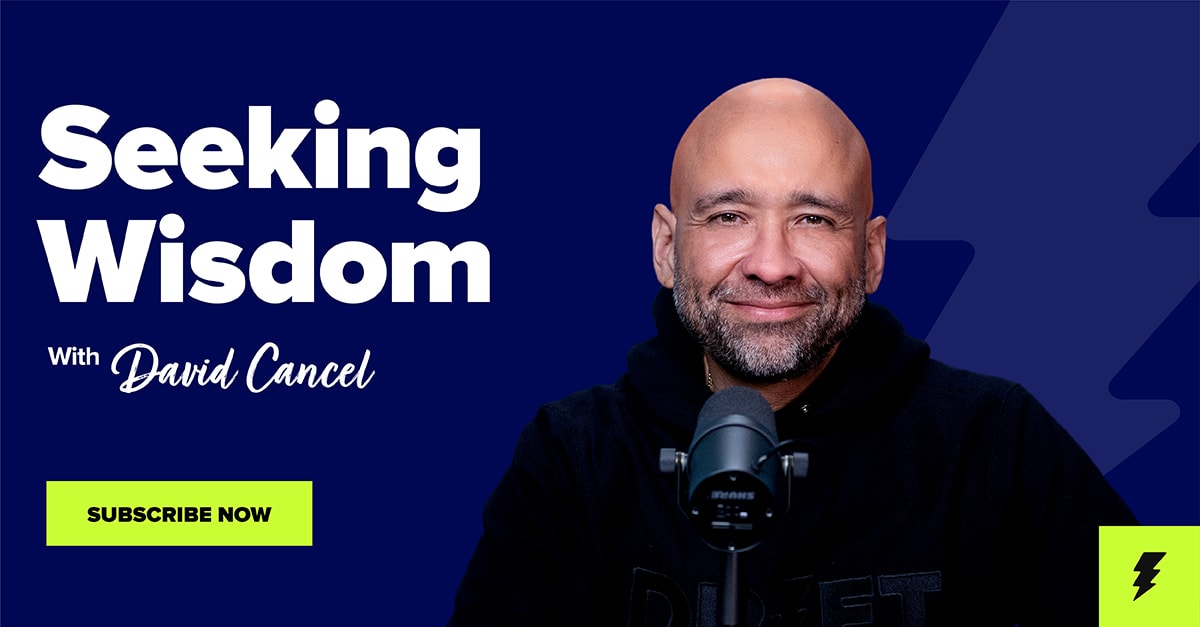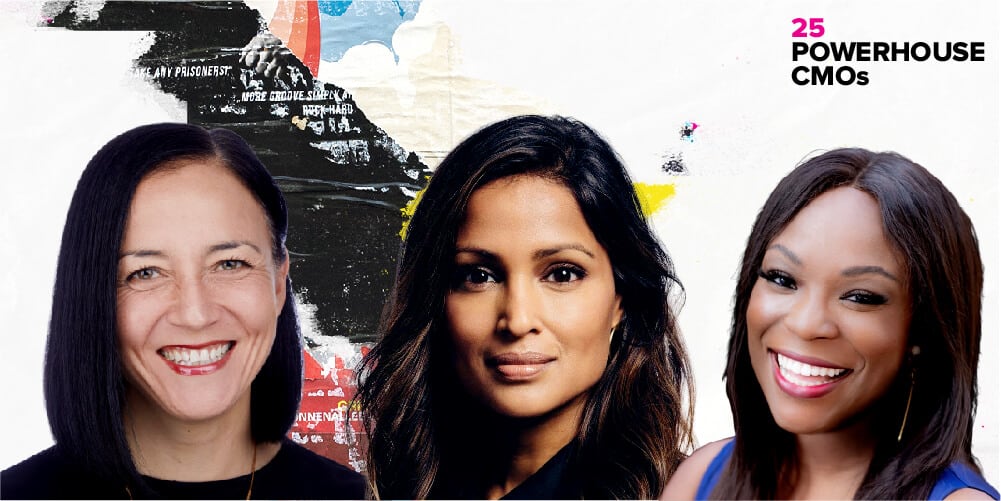Krista Anderson-Copperman understands category creation.
She joined Salesforce in 2000, a year after the company was founded, and saw it grow into a SaaS empire worth billions. She stayed at Salesforce for 13 years in various senior leadership roles focused on customer success, and helped write the playbook for a customer-first strategy that focused on retention, renewals, and growth.
Then, in 2014, she made the move to another hypergrowth, B2B cloud-based company: Okta, acting as their Chief Customer Officer for the next six years and helping grow the company into the 28 billion dollar enterprise it is today.
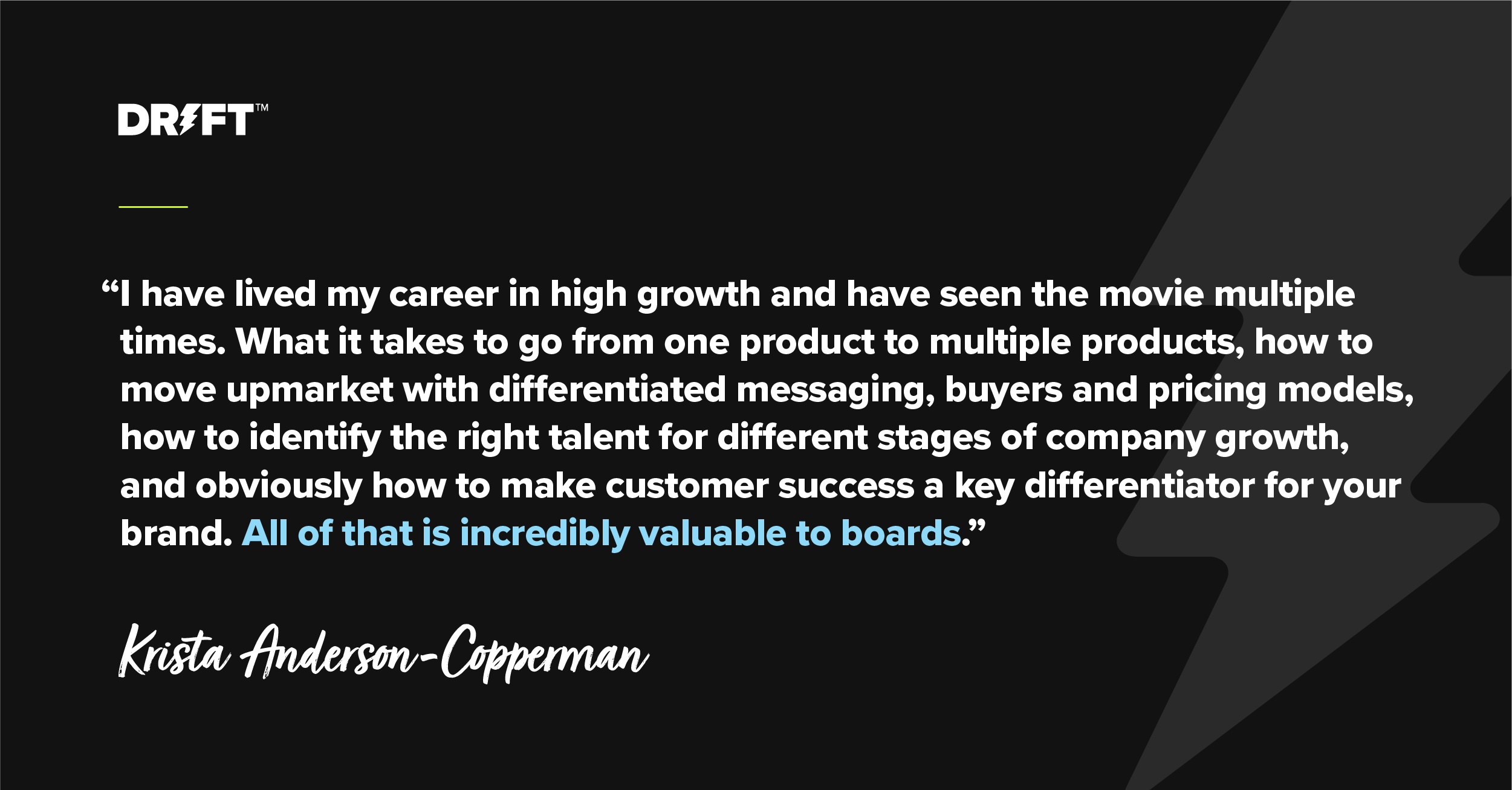
Now, Anderson-Copperman sits on the Board of Directors at Drift, Benchling, and The Advocates for Survivors of Domestic Violence, while also acting as an Advisor for Gainsight. She brings with her a razor-sharp perspective, “I have lived my career in high growth and have seen the movie multiple times. What it takes to go from one product to multiple products, how to move upmarket with differentiated messaging, buyers and pricing models, how to identify the right talent for different stages of company growth, and obviously how to make customer success a key differentiator for your brand. All of that is incredibly valuable to boards,” she notes.
We recently sat down with Anderson-Copperman for a mentorship panel at Drift, where we discussed her expansive career and the lessons she’s learned. Here’s the advice she had to give.
Turn a beginner’s mindset into a competitive edge
Krista Anderson-Copperman didn’t have a background in on-prem when she joined Salesforce, like many of her colleagues at the time. (Marc Benioff had been an executive at Oracle before founding Salesforce, which has since adopted a cloud-hybrid model.)
But this fresh perspective became an advantage, “In many ways, people had preconceived notions or ideas about how things should be done, whereas I didn’t. I was able to truly come with a beginner’s mind, which served me very well.”
So, how did Anderson-Copperman turn a beginner’s mindset into a competitive edge?
By identifying and solving problems. She describes herself as a problem solver in all aspects of her life, so it was a natural fit when she first joined Salesforce as a customer support representative. Her affinity towards identifying and solving problems in the growing business quickly led to a leadership role in support, and ultimately served as the launching point for working her way up and across the organization. In fact, Anderson-Copperman held four different SVP roles during her time at Salesforce (focusing on market adoption, growth, renewals, and net retention).
“In a SaaS model, net retention is a critical factor for the growth and longevity of your company. You can’t ignore it.” Anderson-Copperman says. So, while she was at Salesforce she focused on points of friction when it came to customer retention. From there, she identified a need for education, and then later, a need to incorporate a CSM component to better manage renewals.
These were strategic business moves that strengthened Salesforce’s position in the market – and highlighted Anderson-Copperman’s skill in customer success. And it would never have happened if Anderson-Copperman was chasing titles over experience (and as we know, those titles still followed).
Often, people are wary of taking what might be seen as a “lateral” move within an organization. It’s been drilled into all of us that success equates to climbing the corporate ladder (in a strictly linear fashion). But while upward mobility is important to avoid feeling stuck, don’t underestimate the value in learning a different facet of the business. It’s often vital for leadership. For Anderson-Copperman, these transitions were organic. It staved off career stagnation and gave her an opportunity to broaden her skillset while gaining a more holistic view of the business. In her words, “I had run support. I had run CSM, and I’d run education. But I didn’t have that revenue component with services and renewal.”
So, she took on roles that would help fill those gaps in her expertise.
Gain a holistic understanding of the business, and its place in the market
Switching roles isn’t the only way to learn the ins-and-outs of an organization. One thing Salesforce was adamant about (and that Anderson-Copperman says served her well in learning more broadly about the business) was their V2MOM: Visions, Values, Mission, Obstacles, and Measures. Salesforce describes theirs as a “living document,” meant to align teams by charting a clear path forward for the business.
“Seek out your company’s strategic plan and strive to truly understand all of the components. Getting that broad perspective of the plan should provide will serve you immensely well at every point in your career,” Anderson-Copperman recommends.
You can find an outline of a business’ vision, mission, and leadership principles at any organization, and it is definitely a document to study. It lends itself to big-picture thinking – where does this business fit in the market, what are the top priorities, and how can I help achieve those goals?
Those are the questions that will propel you forward.
Put in the right work and the right position will follow
Here’s a question that won’t get you promoted: how do I get a better title?
There’s nothing wrong with having a certain position in mind when mapping out your career goals. But do you understand the day-to-day responsibilities that come with the role? Even more important: is that the type of work you want to be doing?
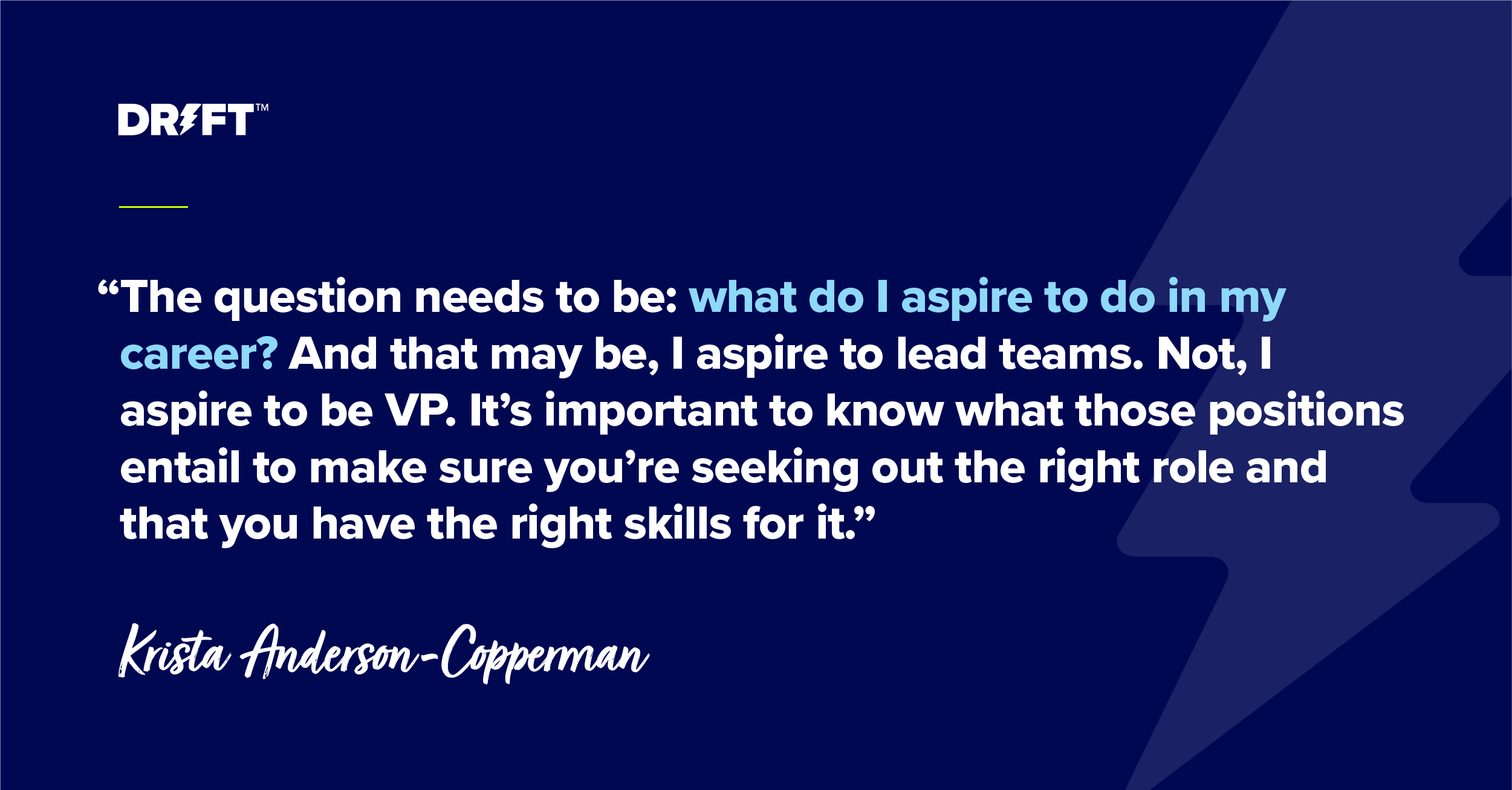
As Anderson-Copperman notes, “The question needs to be: what do I aspire to do in my career? And that may be, I aspire to lead teams. Not, I aspire to be VP. It’s important to know what those positions entail to make sure you’re seeking out the right role and that you have the right skills for it.”
If you’re disinterested in what you’re doing, work will quickly become a grating experience. And going through the motions won’t get you noticed. Understanding the broader context of the business (and your specific impact) can make all the difference.
“It’s really important that you’re doing the right work, and focusing on things that are helpful to the organization. That’s table stakes.” Anderson-Copperman clarifies. That’s what sets people apart.
Make diversity and ESG programs cross-functional, collaborative, and actionable
“If you are building a long-term iconic company, you cannot do it just by selling more products. You do that by being a company that has all the right values, with diversity and ESG [environmental, social, and governance], being a key component of it,” says Anderson-Copperman.
At Okta, there was a conscious effort to make ESG cross-functional and collaborative. “We made it very clear that these diversity and ESG initiatives were for everyone at the organization.” Meaning, everyone needed to come together to make for a more ethical and equitable workplace. Diversity and ESG shouldn’t be something that one group is lobbying for, but something that everyone is working toward.
By taking this approach, people that may have been hesitant to speak up, or ask questions, came forward to learn how to be better advocates. This created ambassadors across engineering, sales, finance, marketing, and so on – which helped to embed diversity and ESG into the company culture. It made it actionable.

“Diversity is good for business. Period, end of story,” Anderson-Copperman states. This has been proven time and again. A McKinsey report found that, for the 366 companies it surveyed, more diverse companies were 35% more likely to have better financial returns than their competitors. On top of that, a Deloitte study found that diversity and inclusion can increase innovation by 20%.
Speak up, and seek out opportunities
This next piece of advice echoes another speaker we’ve been lucky to have at Drift, Joan Wallace-Benjamin (who’s held various CEO positions throughout her career in the non-profit sector). Both women were clear: when it comes to making a name for yourself in the workplace, it’s better to be bold.
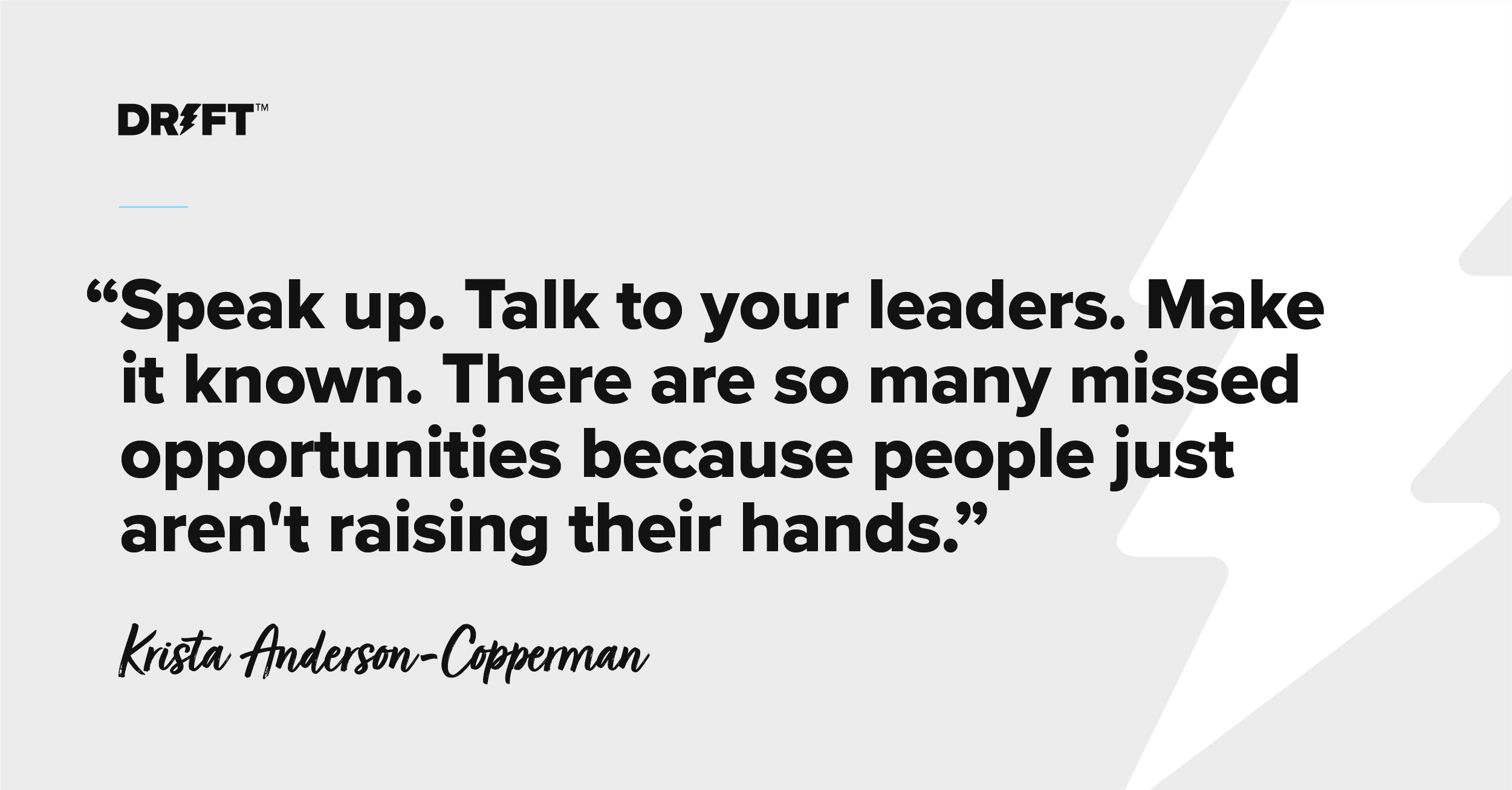
“Speak up. Talk to your leaders. Make it known. There are so many missed opportunities because people just aren’t raising their hands,” Anderson-Copperman notes.
Putting yourself out there can be a daunting prospect. Anderson-Copperman knows this first-hand: a self-described introvert, social, sales-oriented environments are not the most natural settings for her. But she passed on a helpful reminder: “No one got promoted for being the last person at the bar.”
You don’t have to close out a happy hour or the networking event to get ahead. But you do have to show up, participate, and build relationships. The same goes for seeking out mentors: at the end of the day, you’re just asking for a conversation. And the guidance, support, and insight you can gain from these connections will pay off in spades.
Know when to shift your priorities
Can you have it all?
That’s the question that often lurks beneath larger discussions of balancing a family, personal life, and a career. (And it’s one that women seem to field much more often than men.)
Anderson-Copperman has found that the most realistic answer is, “Yes, you can have it all… Just not all at once.”
That doesn’t mean that you have to ignore or disregard certain aspects of your life entirely. It’s more so a game of prioritization. “I’m an extraordinarily organized person,” Anderson-Copperman admits, and the construct that has worked for her has been to categorize the important areas of her life into buckets: her family, her friends, her health, her career, her hobbies. And at any given time, determine which areas need more focus than others.
It’s a dynamic that’s constantly shifting.
“The key is transparency,” Anderson-Copperman advises, “and setting expectations.”
There have been times when Anderson-Copperman has had to adjust the way she worked, whether to support close friends in times of need or prioritize her own health. And while she still worked full-time and fulfilled her day-to-day responsibilities, she was clear with colleagues and her leadership that her approach to work would temporarily change for these reasons.
When you’re a hard worker and a top performer, there should be a certain level of trust among teammates and management to give people this flexibility. (Something that’s all the more relevant considering this past year as the world dealt with a global pandemic.)
Final thoughts
Krista Anderson-Copperman’s career has definitely been impressive: a string of leadership positions and a guiding hand in creating an essential new branch of business in CSM.
And one of the most prominent themes in our discussion was perspective. It was Anderson-Copperman’s fresh perspective that gave her an advantage in those early days at Salesforce. As a board member, she’s adamant about keeping up with broader industry trends to anticipate market shifts and pinpoint key differentiators (she recommends the Crunchbase and MIT email newsletters, as well as the a16z podcast).
So when setting your sights on that promotion, ask yourself deeper questions than simply, how do I get it? Think of the skills you need to cultivate and the problems you need to solve. Or in Anderson-Copperman’s words: put in the right work.





